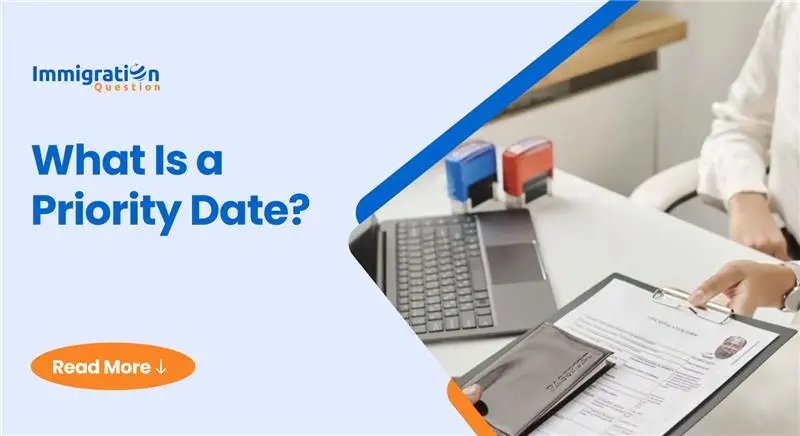If you’ve ever scratched your head over immigration terms, you’re not alone. One question that pops up repeatedly is: ‘What is a priority date?’ Congratulations—you’re already ahead of the game if you’re asking this.
In the world of green cards, visas, and complicated forms, the priority date is one of the most important pieces of the puzzle. It’s like your place in line at the immigration DMV. The sooner you understand it, the more control you have over your immigration journey.
Let’s break down everything you need to know about this term. Whether you’re a client, a paralegal, or an Immigration Question Lawyer trying to explain this to someone for the fiftieth time—this guide’s got you.
What Is a Priority Date?
Your priority date is when the U.S. Citizenship and Immigration Services (USCIS) receives your immigrant petition. It marks the beginning of your wait time for a visa number under the family-based or employment-based immigration categories.
In simpler terms, it’s your timestamp on the green card line.
You receive a priority date when one of the following forms is filed:
- Form I-130 (for family-based immigration)
- Form I-140 (for employment-based immigration)
- Form I-526 (for immigrant investors)
This date is your key to moving forward. Once your priority date becomes “current,” you can finally apply for a green card. Until then? You’re in a waiting game.
Why Your Priority Date Is So Important
Immigration law isn’t “first come, first served” for everyone. There are visa limits for each category and country. Some nationalities and categories face longer backlogs than others. So, even if you applied years ago, you can’t get a green card until there’s a visa number available for your group.
Here’s what makes your priority date so critical:
- It controls your timeline
- It determines when you can take the next step
- It affects your work, travel, and family plans
Still confused? Think of it this way:
Your priority date is like booking a concert ticket. Just because you have the ticket doesn’t mean the show starts immediately. You must wait until the curtain rises (when your date becomes current).
Key Facts About Priority Dates (Bullet Breakdown)
If you remember nothing else, keep these key points in mind:
- It’s NOT your approval date– It’s the date USCIS receives your petition.
- It’s your spot in line. – Determine when a visa number is available.
- It’s different for everyone. – It depends on your category and country.
- It’s tied to the Visa Bulletin – This monthly update shows who’s up next.
- Your Immigration Question Lawyer can help – Tracking the Bulletin can be confusing.
Where Do You Find Your Priority Date?
You can find it on your Form I-797 (Notice of Action), which USCIS mails after receiving your petition. It’s usually listed near the top as the “Priority Date.” If your petition is approved, it’ll also be shown on your approval notice.
Lost your form? No worries—your Immigration Question Attorney can request a duplicate.
What Does “Current” Mean?
“Current” means your priority date is earlier than the date listed in the Visa Bulletin for your category and country of chargeability. When it becomes current, you can file Form I-485 (if you’re in the U.S.) or start consular processing (if you’re abroad).
– If your category is marked as “C” (for current) in the Visa Bulletin, it means there’s no wait—you can file immediately.
How Immigration Question Attorneys Track the Visa Bulletin
This bulletin—published monthly by the U.S. Department of State—lists cutoff dates by country and visa category.
It includes:
- Family-sponsored preferences
- Employment-based preferences
- Diversity visa information
Each visa category and country has a specific date. You’re good to go if your priority date is on or before that date!
Example:
If you’re from India and your employment-based second preference (EB-2) priority date is January 15, 2015, and the Visa Bulletin says January 1, 2016, you can move forward.
Still confused? You’re not alone. Many people turn to their Immigration Question Lawyer for the Visa Bulletin each month. It’s part math, part mystery.
What Affects How Fast Your Priority Date Moves?
Oh, this is the million-dollar question.
Several things slow—or occasionally speed up—priority date movement:
- High demand from your country
- Low annual visa caps
- Per-country limits
- Processing delays at USCIS or the National Visa Center
- Policy changes (which can shuffle priorities)
For example, countries like India, China, Mexico, and the Philippines often experience the longest wait times due to high demand.
Can Your Priority Date Change?
Usually, no. But in some cases, it can:
- Upgrading Your Petition
If you’re in the F2B category (unmarried adult children of green card holders) and your sponsor becomes a U.S. citizen, your petition may be upgraded to F1 (unmarried adult children of citizens). The good news? You keep your original priority date.
- Filing a New Employment Petition
You might retain your previous priority date if you change jobs and file a new I-140. This is known as porting.
Your Immigration Question Attorney can confirm if your situation qualifies.
What Happens After Your Priority Date Is Current?
Good question. Once your date is current, you can finally take action.
- If You’re Inside the U.S: You file Form I-485 to adjust your status to permanent resident.
- If You’re Outside the U.S.: You go through consular processing by completing the DS-260 and attending an interview at a U.S. embassy or consulate.
Either way, your Immigration Question Lawyer will help you gather the documents, prep for interviews, and ensure nothing’s missing.
What If You Miss Your Chance?
Yikes. You don’t want that.
If your date becomes current and you don’t act, your file may be delayed—or worse, shelved. USCIS and the National Visa Center do not chase you down.
Stay proactive. Check the Visa Bulletin monthly, or let your Immigration Question Attorney do it.
Immigration Question? Communication is Key
At ImmigrationQuestion.com, we hear this often: “I had no idea my priority date became current until it was too late.”
That’s why communication between immigration question attorneys and clients is everything. A reliable case management system can:
- Send alerts when a date becomes current
- Organize client documents
- Track form deadlines
- Keep everyone in the loop without hundreds of emails
Better communication = fewer missed opportunities.
Priority Dates and Retrogression
Just when you think you’re ready to file, a thing called retrogression can show up. This means the priority date that was current last month has suddenly moved backward.
Yes, it’s frustrating.
Retrogression can happen when visa demand exceeds supply. If this happens after you file I-485, USCIS will put your application on hold until your date becomes current again.
The moral of the story? File immediately when your date becomes current.
Final Thoughts
The heartbeat of your immigration journey is your priority date. It determines when you can start a new life, move on, change your status, and reunite with loved ones. It’s essential to remain informed and organized. And with the right support team – including your case management software and Immigration Question Lawyer- you’ll be more than prepared when the right opportunity comes knocking.
- Don’t let missed updates, disorganization, or delays hinder your firm or clients.
- Try it now—and stay ahead of every deadline, every step of the way.
Frequently Asked Questions
What is an immigration priority date in the United States?
It is the day your petition (I-130, I-140, or I-526) is received by USCIS. Based on the visa’s availability it’s used to determine when you can petition for a green card.
How will I know whether my priority date is current or not?
Examine the Department of State’s monthly Visa Bulletin. Compare your category and country with the listed dates. If your date is before the cutoff, it’s current.
Can my priority date be transferred to a new petition?
At times, yes. Employment-based petitioners who file a new I-140 or change employers may retain their original priority date. Talk to an Immigration Question Attorney to determine if it can be done.






